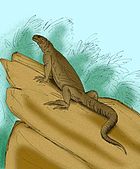Lapitiguana: Difference between revisions
| [pending revision] | [pending revision] |
Content deleted Content added
No edit summary Tags: Mobile edit Mobile web edit |
Apokryltaros (talk | contribs) m Reverted 1 edit by 2602:252:D06:1790:C9F0:714E:DD81:11BC (talk) to last revision by Apokryltaros. (TW) |
||
| Line 1: | Line 1: | ||
{{speciesbox |
{{speciesbox |
||
| fossil_range = |
| fossil_range = [[Holocene]]{{fossilrange|.011|.003|}} |
||
| image = Lapitiguana impensa.JPG |
| image = Lapitiguana impensa.JPG |
||
| image_caption = Comparison of ''[[Viti Levu giant pigeon|Natunaornis]]'' and ''Lapitiguana'' |
| image_caption = Comparison of ''[[Viti Levu giant pigeon|Natunaornis]]'' and ''Lapitiguana'' |
||
Revision as of 00:42, 22 April 2018
| Lapitiguana Temporal range: Holocene
| |
|---|---|

| |
| Comparison of Natunaornis and Lapitiguana | |
| Scientific classification | |
| Domain: | Eukaryota |
| Kingdom: | Animalia |
| Phylum: | Chordata |
| Class: | Reptilia |
| Order: | Squamata |
| Suborder: | Iguania |
| Family: | Iguanidae |
| Genus: | †Lapitiguana |
| Species: | †L. impensa
|
| Binomial name | |
| †Lapitiguana impensa Pregill & Worthy, 2003
| |
Lapitiguana impensa is an extinct giant (1.5 m long) iguanid from Fiji.[1] It probably became extinct following the human colonization of Fiji 3000 years ago.[1]
All extant Fijian iguanas are in the genus Brachylophus, together with an extinct species from Tonga. The closest living relatives of the Polynesian iguanas are found in the Americas,[2][3] posing a biogeographical puzzle.
See also
References
- ^ a b Pregill, G. K.; Worthy, T. H. (March 2003). "A New Iguanid Lizard (Squamata, Iguanidae) from the Late Quaternary of Fiji, Southwest Pacific". Herpetologica. 59 (1). The Herpetologists' League: 57–67. doi:10.1655/0018-0831(2003)059[0057:ANILSI]2.0.CO;2.
- ^ Keogh, J. Scott; Edwards, Danielle L.; Fisher, Robert N.; Harlow, Peter S. (2008-10-27). "Molecular and morphological analysis of the critically endangered Fijian iguanas reveals cryptic diversity and a complex biogeographic history". Philosophical Transactions of the Royal Society B. 363 (1508). Royal Society: 3413–3426. doi:10.1098/rstb.2008.0120. PMC 2607380. PMID 18782726.
- ^ Noonan, B.P.; Sites, J.W. Jr. (2009-11-24). "Tracing the origins of iguanid lizards and boine snakes of the Pacific". The American Naturalist. 175 (1). University of Chicago Press: 61–72. doi:10.1086/648607. PMID 19929634.
External links





